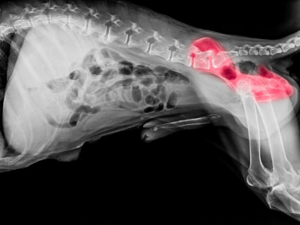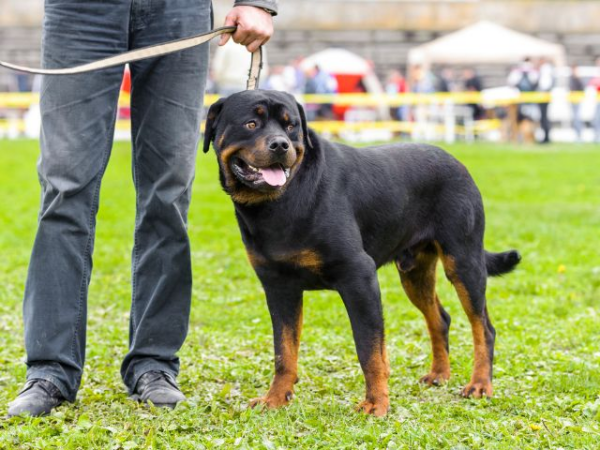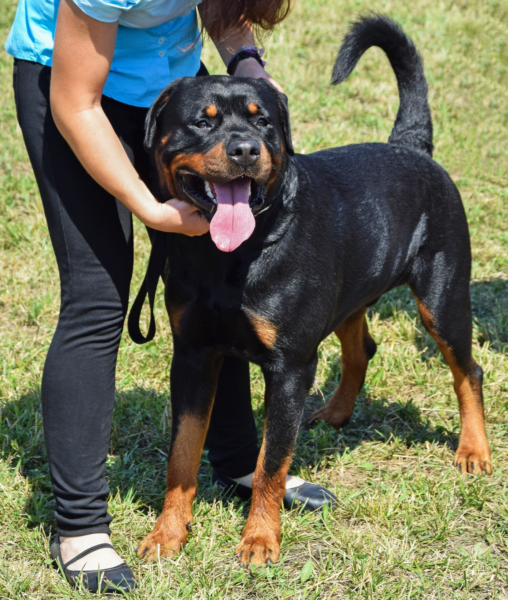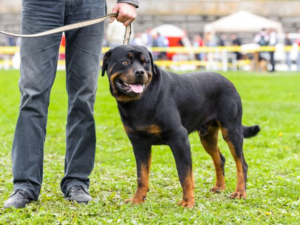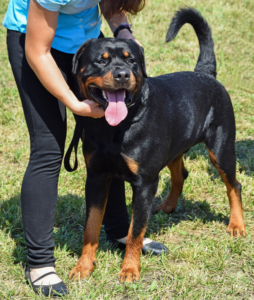Around 20% (or one in five) Rottweilers may be affected by hip dysplasia [1]; a potentially crippling condition that can seriously affect your dog’s ability to get around comfortably, and to enjoy exercise. Hip dysplasia can also cause pain and discomfort at rest, and can shorten your Rottie’s overall lifespan due to pain that becomes unmanageable leading to euthanasia, or due to loss of ability to use the hind legs.
Overall, it’s a serious concern, and every Rottweiler owner should ensure they are well informed about the ins and outs of the condition. In this article, we’ll discuss what hip dysplasia is; the signs of hip dysplasia in dogs; prevention; treatment; and prognosis.
Interested to learn about other common health problems in Rottweiler? Read here now.
You can also read about progressive retinal atrophy in Rottweilers here.
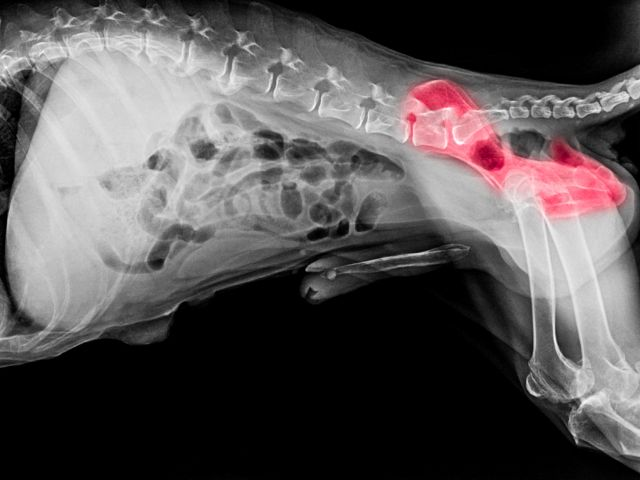
What is Hip Dysplasia?
“Dysplasia” means abnormal development, and once you know this, the term hip dysplasia makes a whole lot more sense. Hip dysplasia in dogs is a condition where the hip joint (or coxofemoral joint) doesn’t develop properly.
The hip is commonly referred to as a ball and socket joint, with the ball being the head of the femur (thigh bone), and the socket being a cup-shaped part of the pelvis medically referred to as the acetabulum. In canine hip dysplasia, the “ball” of the joint doesn’t fit well inside the “socket”. This results in instability and laxity (looseness) in the joint, which eventually leads to the development of osteoarthritis.
Unfortunately, in severe cases arthritis can actually develop very quickly, meaning the eventually might be as soon as a few months of age! The secondary osteoarthritis that is an inevitable consequence of hip dysplasia causes increasing degrees of pain and lameness over time, and many owners will notice the disease at this stage as their dog may limp or have difficulty moving.

How Can You Tell if a Dog Has Hip Dysplasia?
Dogs with hip dysplasia typically start showing signs of the disease between six and twelve months of age, and the severity of these signs can vary dramatically. Dogs with mild hip dysplasia may only have very subtle signs that anything is wrong (and diagnosing hip dysplasia in these individuals can be challenging), whereas severely affected dogs are often easy to identify.
Interestingly from a veterinarian’s perspective, we find that the severity of the hip dysplasia on X-rays doesn’t always line up with how affected (or relatively unaffected) the dog is “in real life”. Sometimes, the hips will look terrible on X-ray but the dog will be fairly comfortable with reasonable mobility. In other cases, the hips will appear to be only mildly affected on X-rays yet the dog will be significantly lame.
Large breed dogs are significantly more likely to be affected than small breed dogs, and some specific breeds are more likely than others to be affected. This is because there is a strong genetic component to the condition. Whilst it’s not as simple as saying that hip dysplasia is a purely genetic disease (in reality there are multiple factors involved, with the diet of young dogs being really important), it’s certainly true that genetics play the largest part.
Breeds with a known genetic predisposition to developing this unpleasant degenerative joint disease include Labrador Retrievers, Bernese Mountain dogs, Golden Retrievers and German Shepherds [2], and Rottweilers [3].
The signs of hip dysplasia that every large breed dog owner should be aware of include:
- Limping on one or both rear legs
- Moving abnormally, for example, stiffness, a swaying walk, or “bunny hopping” when running. This bunny hop is especially characteristic of hip dysplasia in dogs
- Refusal or reluctance to exercise
- Difficulty rising, sitting, or lying down
- Problems or refusal when it comes to climbing steps, or jumping in and out of the car
- Being protective when the hips or back legs are touched or handled, for example, during grooming
- Weakness or slowed responses in one or both back legs [4]
- Yelping, whimpering, or other obvious signs of pain*
*Note that this is quite rare. In my experience as a vet, the vast majority of dogs with hip dysplasia don’t show obvious signs of pain, even though they are most certainly painful. Please don’t be fooled into thinking that just because your dog isn’t yelping with their tail between their legs, they aren’t painful.
Dogs in chronic, long-term pain have learned that this is simply part of their daily experience of life. Sadly, it’s the only reality they know, and they aren’t aware that anything can be done about it, so they just on with things. It’s up to you as their guardian, to recognize this key point and be astute enough to still seek veterinary attention and provide pain relief for your pet.
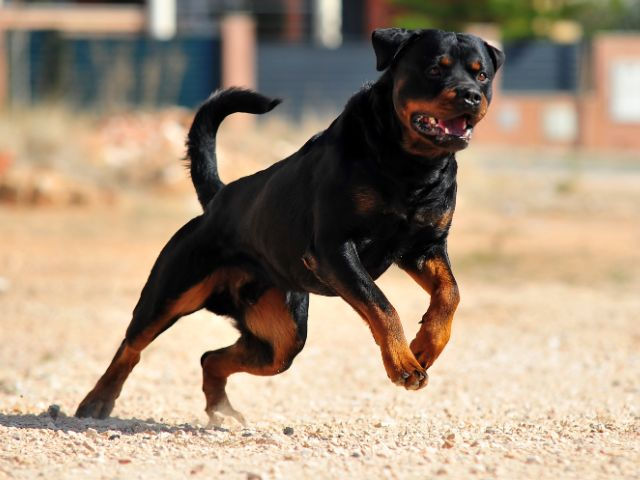
How to Prevent Dysplasia in Dogs?
The absolute best way we can prevent our dogs from developing hip dysplasia is by ensuring that we breed carefully, and only from individuals that we know are not affected, or at least only minimally affected. Careful breeding where only dogs who do not show any signs of hip dysplasia, and who have good hip scores on X-ray assessment, has been proven to result in a steady improvement in the breed’s hip conformation [3].
Currently, participation in hip screening efforts is voluntary rather than mandatory, and frankly, I would love for this to change! It’s very difficult (and expensive) to effectively treat hip dysplasia; in some cases, it’s impossible. So really, we should be focusing our efforts as much as possible on prevention rather than cure.
Now let’s talk a bit about the fact that hip dysplasia in dogs is not a simple disease. As we’ve already discussed, there is certainly a genetic component, but other factors are also important in deciding whether or not a puppy will develop hip dysplasia. Large and giant breed puppies may treble their size in just 12 weeks of adolescence, and with such rapid growth comes extreme potential for skeletal disorders to occur, including the potential for hip joints to form abnormally.
Improper nutrition can cause and contribute to the development of orthopedic issues in large-breed puppies. The essential nutrients required for skeletal growth must be present in a puppy’s diet in just the right proportions and at just the right time.
If you’ll excuse me for becoming passionate for a moment, stupid, unsafe, and faddy diets such as raw meat diets are not only unsafe for human and animal health but are also doing untold harm in terms of contributing to the development of skeletal issues in developing puppies. Steer well clear!
There are also surgical procedures available that can help prevent the development of hip dysplasia in dogs, and reduce the severity of the condition where it does develop. These procedures include juvenile public symphysiodesis (JPS), a preventative surgery that achieves the best results if carried out before 16 weeks of age [5], and triple pelvic osteotomy which can be performed on older puppies, usually less than one year of age.
At What Age Do Rottweilers Get Hip Dysplasia?
Canine hip dysplasia is usually diagnosed between six and twelve months of age, although this can be variable. Mild cases of hip dysplasia may go undetected for several years before owners notice the signs.
See “How can You Tell if a Dog has Hip Dysplasia?” if you are concerned that your Rottie may be affected. It’s important to seek veterinary attention as soon as possible, since some interventions are significantly more effective when treatment is sought early on in the course of the disease.

How Do You Treat Hip Dysplasia in Rottweilers?
Treating hip dysplasia can be challenging, especially since the gold standard treatment for most affected dogs is total hip replacement (THR), which is notoriously expensive. We’ll discuss THR some more under the following heading, and for now, let’s move on to the other means we have at our disposal for treating canine hip dysplasia without surgical intervention.
All dogs with hip dysplasia need to be on a weight management plan to ensure they remain within the normal range at all times. As a vet, I cannot stress enough how important it is that your Rottweiler maintains a healthy weight if they are affected by this condition! Being overweight places extra strain on the hip joints, and this will exacerbate joint pain and the development of secondary arthritic changes. Trust me: it’s not worth the biscuits!
Physical therapy can also be really helpful for dogs with hip dysplasia, and I recommend hydrotherapy for preference. Hydrotherapy will help your Rottie maintain hind limb muscle mass without stressing the hip joints. Side note: a proportion of Rottweilers will concurrently be affected by elbow dysplasia, which hydrotherapy will also help.
In terms of medications, as vets, we focus our efforts on relieving the pain and inflammation caused by your dog’s osteoarthritis. Nonsteroidal anti-inflammatory drugs have been the mainstay of canine arthritis treatment for many years, and are still an excellent choice, but we now also have the Librela injection, a fantastic option for dogs with concurrent kidney disease. Gabapentin, amantadine, tramadol, opioids, and paracetamol may also be prescribed.
Joint supplements can be a beneficial accompaniment to the management plan, but owners should be aware that there’s close to zero chance that a joint supplement alone will be sufficient to adequately remove the discomfort.

What is Total Hip Replacement in Canine Hip Dysplasia?
THR is a surgical intervention that involves removing the head of your dog’s thigh bone and placing an implant that effectively replaces the “ball” portion of the hip joint. To be a candidate, dogs must be in good general health and fully skeletally developed (generally older than 18 months in large and giant breed dogs).
The procedure has a low risk of complications, and around 90-95% of dogs who undergo THR end up with excellent hip function. The recovery time may be relatively long (around 3 months to get back to full activity levels) but it’s well worth it for the outcome.
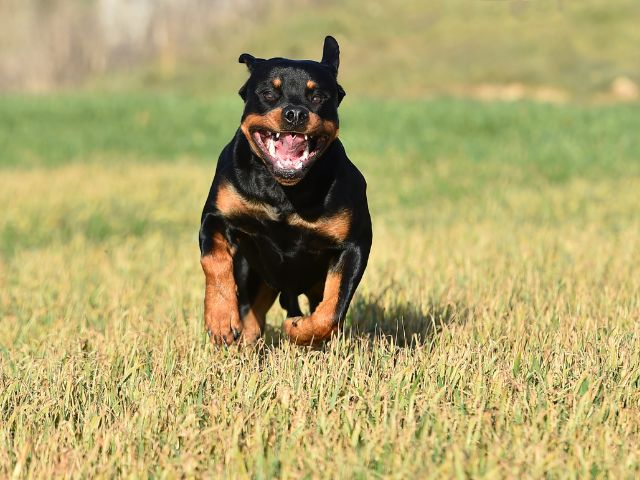
How Long Can Dogs Live with Hip Dysplasia?
The main limiting factor on the lifespan of dogs with hip dysplasia is loss of use of the hind legs, or in some cases, hip pain that is severe and can no longer be controlled with available treatments. Whilst figures for the Rottweiler breed specifically are not reported, one study found that 60% of Labrador Retrievers with hip dysplasia lived past ten years of age, although the same study found that only 16% of Leonbergers and 6% of Irish Wolfhounds made it to this milestone [6].
Speaking from experience, the more time, effort and (I hate to say it, but it’s true) financial input you’re able to provide, and the more closely you work with your vet, the longer your dog is likely to live with hip dysplasia. Find a good vet that you are happy to see regularly, and build a management plan with them that is tailored to your dog. This plan will change over time as your dog’s needs change, so be prepared to adapt.
A final point. If your dog is affected by severe osteoarthritis secondary to hip dysplasia and is living in pain that cannot be rectified (for whatever reason, including financial), as a vet and canine welfare fanatic I urge you not to postpone euthanasia. I’ve seen the harm done to dogs when owners hold on too long. Sometimes, the greatest kindness you can provide to your much-loved companion is letting go at the right time.
Thinking about training your rottie pup? Read here about how to train your Rottweiler puppy at home.
You can read about Rottweiler behavior clicker training here.
References
- Kirberger, R.M. (2017) ‘Phenotypic hip and elbow dysplasia trends in Rottweilers and Labrador retrievers in South Africa (2007–2015): Are we making progress?’, Journal of the South African Veterinary Association, 88.
- Mikkola, L., Holopainen, S., Pessa-Morikawa, T., Lappalainen, A.K., Hytonen, M.K., Lohi, H. and Iivanainen, A. (2019) ‘Genetic dissection of canine hip dysplasia phenotypes and osteoarthritis reveals three novel loci’, BMC Genomics.
- Oberbauer, A.M., Keller, G.G. and Famula, T.R. (2017) ‘Long-term genetic selection reduced prevalence of hip and elbow dysplasia in 60 dog breeds’, PLoS One, 12(2).
- Fitzpatrick Referrals (2024) Hip Dysplasia.
- Dueland, R.T., Adams, W.M., Patricelli, A.J. and Linn, K. (2010) ‘Canine hip dysplasia treated by juvenile pubic symphysiodesis Part I: Two year results of computed tomography and distraction index’, Veterinary and Comparative Orthopaedics and Traumatology, 23(5), pp. 306-317.
- Krontveit, R.I., Trangerud, C., Nodtvedt, A., Doha, I., Moe, L. and Saevik, B. (2012) ‘The effect of radiological hip dysplasia and breed on survival in a prospective cohort study of four large dog breeds followed over a 10 year period’, The Veterinary Journal, 193(1), pp. 206-211.

